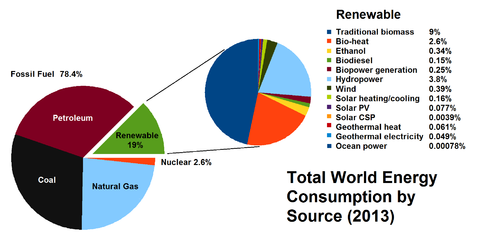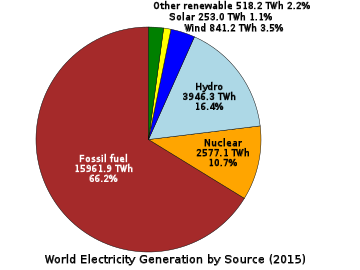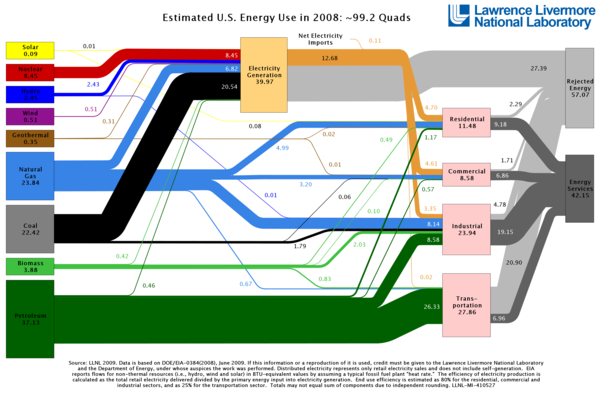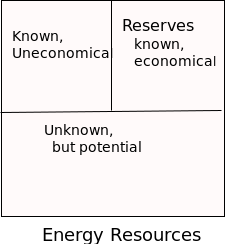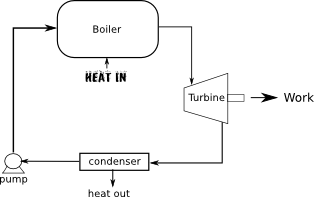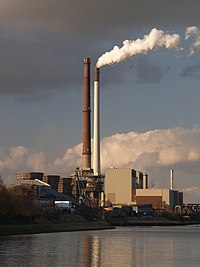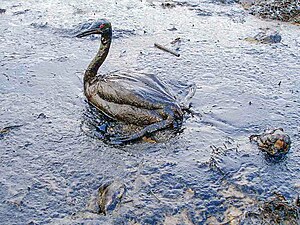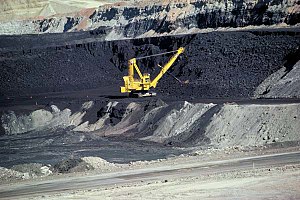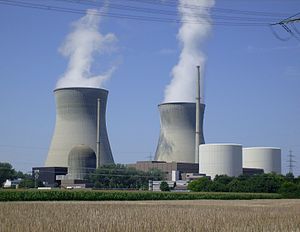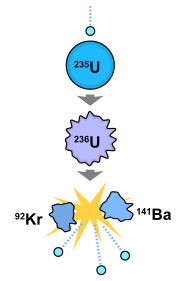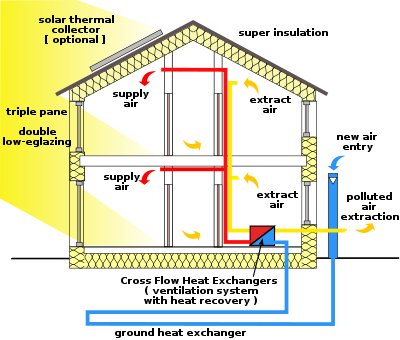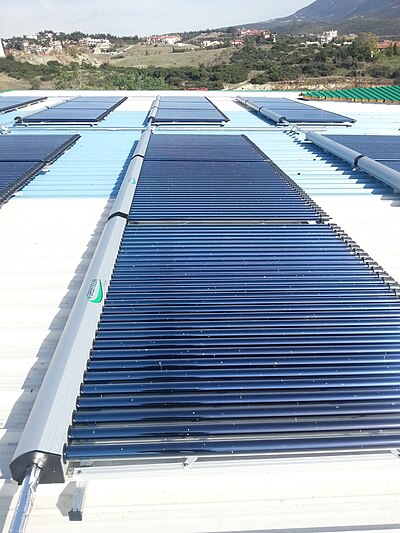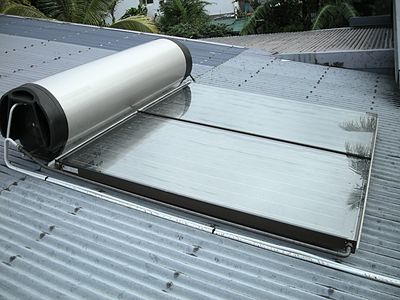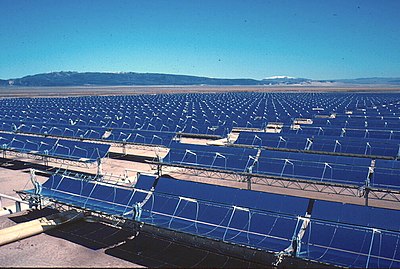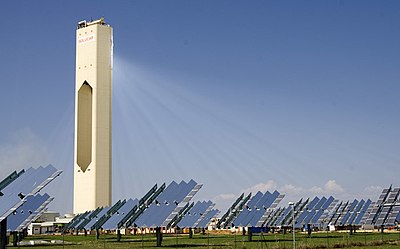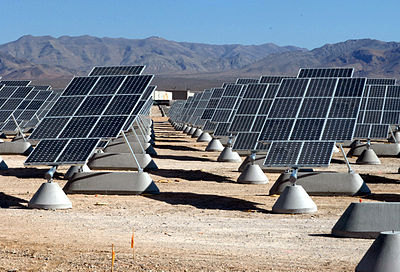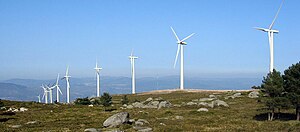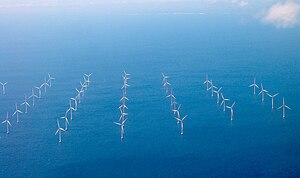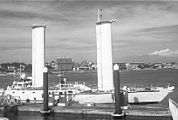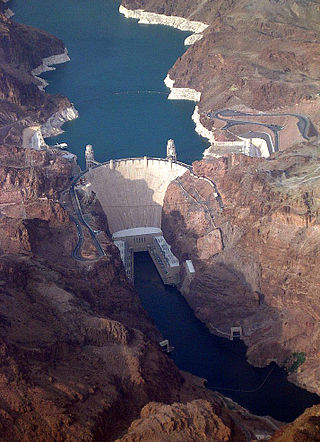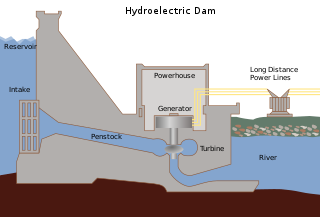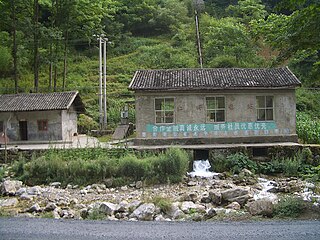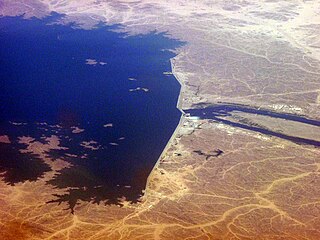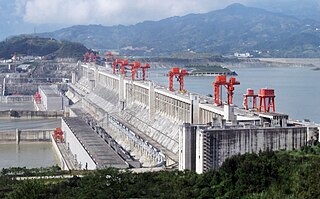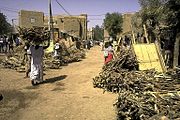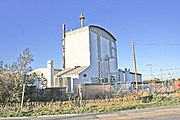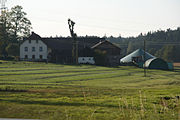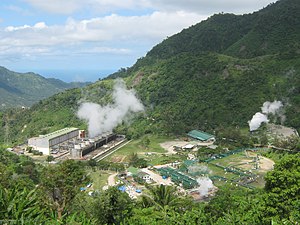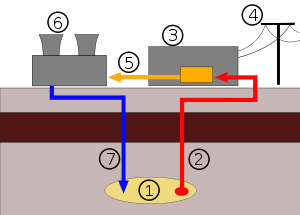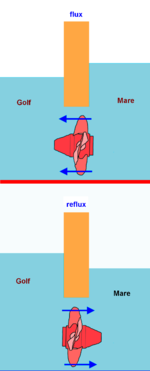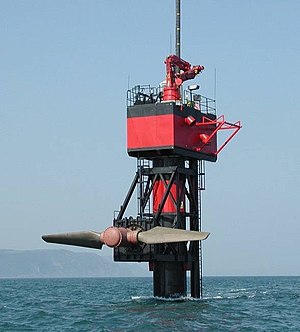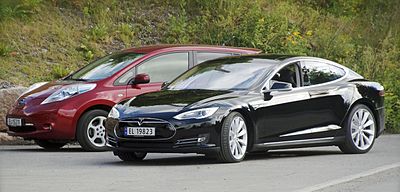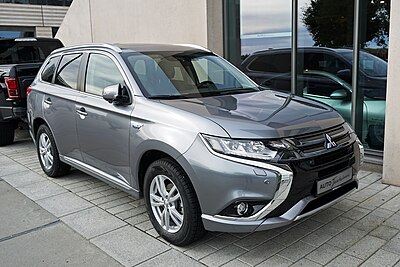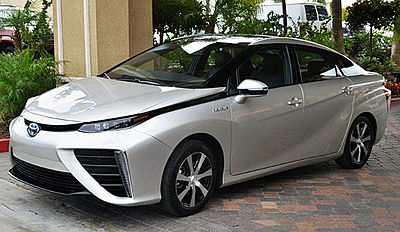Energy
| Environmental Science | |
|---|---|
| Topics | What is the Environment | Planetary Boundaries | Ecological Footprint and Sustainable Development | Food and Agriculture | Population | Ecology - Definitions and Outline | Energy Flow in Ecosystems | Population and Community Ecology | Material Cycles | Biodiversity | Energy | Atmosphere and Climate | Global Warming | Air Quality | Water Quantity | Water Quality | Solid Waste |
|
Contents
Energy usage
Definitions
- Total Primary Energy Supply (TPES)
- Energy production + imports - exports ± stocks
- Total Final Consumption (TFC)
- Consumption of energy by the final users
Note these are not the same due to loss of energy from refinement of energy to usable forms, from transport, and from losses in electric generation.
For example, crude oil must be made into gasoline (and other products) and then transported to the gas station.
Units
- Ton of oil equivalent
- amount of energy in one metric ton of oil
Examples of conversion factors:
- 1 ton of gasoline = 1.05 toe
- 1 ton of kerosine (jet fuel) = 1.10 toe
- 1 ton of coal (anthracite) = 0.77 toe
- 1 ton of coal (lignite) = 0.36 toe
- 1 ton of ethanol = 0.71 toe
- 1 ton of wood = 0.52 toe
- 1 ton of natural gas = 1.29 toe
- 1 ton of hydrogen = 3.38 toe
- Joule (J)
- SI unit for energy. 1 toe = 42 GJ
- Kilowatt-hour (kWh)
- usually used for electricity. 1 kWh = 3.6 MJ
World Usage (2019)
World Total Primary Energy Supply 14,282 Mtoe
World Total Final Consumption 9,938 Mtoe
Electricity Generation 26,619 TWh
Usage per Country
Energy usage varies widely among different countries
The table below gives the total primary energy supply per capita [toe per capita] for the year 2018 for selected countries [1]
Bangladesh 0.3 Senegal 0.3 Nepal 0.5 Kenya 0.5 India 0.7 Kyrgyzstan 0.7 Guatemala 0.8 Nigeria 0.8 Vietnam 0.9 Indonesia 0.9 Egypt 1.0 Brazil 1.4 Thailand 2.0 China 2.3 South Africa 2.3 United Kingdom 2.6 Japan 3.3 France 3.6 Germany 3.6 New Zealand 4.2 Russian Federation 5.3 South Korea 5.4 United States 6.7 Canada 8.0 Kuwait 8.2 Qatar 15.6
Energy usage is usually divided into four sectors:
- Industrial
- Residential
- Commercial
- Transportation
Energy sources
Types of energy sources:
- renewable
- nonrenewable
- Nonrenewable energy sources
- Energy sources which are used much faster than they are produced
- Renewable energy sources
Energy sources which are produced rapidly or continuously
Energy and Electricity Sources
Energy flow chart
Energy can be shown by using an energy flow chart
The above figure shows the flow of energy in the United States. The left is the different energy sources, while the right shows the four sectors. Note that about 40 % of the energy is used to make electricity. Also note the Rejected Energy (in gray). It is 58% of all energy (more than half). This is partly due to the second law of thermodynamics and partly due to use of inefficient equipment.
Nonrenewable Energy
Nonrenewable energy consists of:
- Fossil fuels
- Nuclear energy
Fossil Fuels
- Fossils fuels
- created when dead organic matter is subject to high temperatures and pressure over millions of years. Fossil fuels include oil, coal, and natural gas.
- Energy reserves
- known deposits which can be extracted economically
Uses
- Electricity generation
- Other energy uses - heating, cooling, transport, etc.
- Petrochemicals and plastic
- Coke for steel production
Electricity generation
Since a large part of energy is used for electricity generation, let us look at how the majority of electricity is made. The key part of a power plant is the power cycle:
Water is heated in the boiler to create steam. The boiler can be heated by coal, oil, natural gas, nuclear, thermal solar, biomass, or geothermal. The steam is then used to drive a turbine. The turbine consists of blade attached to a shaft. The shaft is connected to a dynamo to generate electricity. The steam leaving the turbine is then condensed back to water (releasing heat) and then pumped back to the boiler.
21 percent of electricity is produced by direct energy conversion - photovoltaic solar, wind, or hydropower.[note 1]
Environmental impacts and costs
- Global Warming (burning of fossil fuels)
- Air pollution
- Oil spills (from tanker ships, pipelines, wells, rail and truck tankers, oil facilities)
- Oil drilling (land and sea) - especially in vulnerable areas such as the arctic
- Natural gas pipeline leaks (methane is a greenhouse gas)
- Coal mining (destruction of habitat, changing of landscapes, acid drainage)
Other impacts
- Limited supply
- Energy security
Fossil fuel subsidies
Fossil fuel subsidies total (2015) US$5.3 trillion per year[2] world-wide. Equal to 6.5% of the world's GDP.
These subsidies[2]:
- Damage the environment increasing air pollution and global warming
- Impose large fiscal costs
- Discourage investment in energy efficiency and renewable energy
- Highly inefficient way of to support low-income families. Most subsidies go to rich households
Nuclear Energy
Nuclear energy is using nuclear fission to produce heat (instead of coal, etc.).
The fuel used is uranium-235. A nuclear reaction occurs which produces high amounts of energy. This reaction is self-sustaining.
Note that mined uranium must be processed to be used as fuel since only 0.7% is U-235 (99.3% is U-238 which is non-fissionable). For use as a fuel uranium needs to at least 3 to 5 % U-235.
Advantages
Lower (but not zero) greenhouse gases
Adequate fuel supply
Disadvantages
Safety - with high radiation the potential for a severe accident is always present.
Nuclear waste - The waste fuel is extremely radioactive and long-lived.
Nuclear proliferation - There is concern that fissionable uranium or plutonium good get into the hands of terrorists and criminals.
High cost
Low efficiency - 25% vs. 30% for fossil fuels.
Renewable Energy Sources
Introduction
Fossil fuel production is about 30 percent efficient, about two-thirds of that is due to the Second Law of Thermodynamics. However, many forms of renewable energy -- solar cells, wind, hydropower -- are direct energy conversion and are not restricted by the Second Law.
Facts about renewable energy:
- Renewable energy is not expensive. It is now cheaper than renewable energy. (see additional comments below)
- the capacity for renewable energy has grown rapidly in recent years
- In 2019, renewables accounted for 75% of all new global power capacity[3]
Solar Energy
Solar energy refers to using the energy directly from the sun
There are four types of solar energy
- Passive solar
- Uses solar energy directly to heat a space. Passive means no moving parts.
- Active solar
- Uses solar energy for heating or cooling. Active systems contain moving parts (for example, a pump).
The biggest use of active solar systems is for producing hot water.
- Thermal solar
- Using solar energy as the heat source in a power plant. Also known as concentrated solar power (CSP).
- Photovoltaic cells
- These convert solar energy directly into electricity using electronics.
- Previously, these were considered expensive. However, that has changed recently -- to quote the Global Status Report, 2015, "...rapidly falling costs had made unsubsidised solar PV-generated electricity cost-competitive with fossil fuels..."[3]
Wind Energy
Converting the wind into electricity using turbines. Usually produced using horizontal-axis turbines on wind farms.
Off-shore wind farms
Major disadvantage to wind farms is they require a large amount of land space.
An increasingly common way to avoid this is to use offshore wind farms.
Advantages of wind power
- Extremely efficient
- Fastest growing energy technology[3]
- 42% of electricity production in Denmark in 2015[3]
- Including health impacts, wind power is the cheapest form of energy[4]
Wind farms and birds
- Often cited is the hazard to birds
- However, studies show that many more birds are killed by buildings, cats!, and air pollution. Only 0.0001% of bird kills are due to wind turbines.[5]
- The Royal Society for the Preservation of Birds (RSPB) supports wind power, after proper siting studies have been completed.[6]
Other types of wind power
Vertical-axis turbines - in these the main shaft is vertical. The main advantage is that they do not have to be pointed into the wind direction. This is especially useful in areas where the wind is not in one prevailing direction.
The major disadvantage is that the forces on the turbine are higher causing increased stress on the equipment.
Windmills pump water instead of producing electricity.
Sails are surfaces used to move a boat, etc. by the wind.
Hydroelectric Power (Hydropower)
Using the power of flowing water to drive a turbine
Most hydropower is large scale - using a large dam to create a reservoir
Small-scale hydropower is using a small dam (or no dam) with no reservoir
Issues: large dams can be very destructive to the environment (see Web Resources below):
- Flooding of upstream ecosystems
- Reduced flow to downstream riverine ecosystems
- Fragmentation of river ecosystems
- Reservoir sedimentation
- Methane emissions
Large dams also create social problems
- Relocation
- Reduction of flow to downstream communities
Most small-scale hydropower avoids these issues and are considered sustainable
Biomass
Biomass is the use of plant and animal material as an energy source
Types:
- Direct burning for heating and cooking (by far the largest usage, mostly wood used for cooking and heating)
- Burning to produce heat for electrical generation
- Biogas - Production of methane from waste products
- Biofuels - Making liquid fuels as replacement for gasoline and diesel fuel
Biofuels
Biofuels are controversial. To understand that we need to know the difference between first and second generation biofuels.
- First generation biofuels
- Crops grown specifically for biofuel production
- Second generation biofuels
- Waste products are used to produce the biofuels
The controversy deals with first generation biofuels only.
Issues with biofuels
A major problem with first generation biofuels is that the planting of crops either reduces the amount of land available for food crops or is cleared from native forests
Geothermal energy
This is using the heat trapped underground either for direct heating or as a heat source for electrical generation
It is the same mechanism as found in hot springs
Geothermal Power Plants
Geothermal power plants use steam generated underground to either directly or indirectly to drive a turbine.
Geothermal Heating
About half of all geothermal energy is direct heating. Most common usage is for:
- District heating
- Bathing (spas, onsens, etc.)
- Industrial processes
- Fisheries and greenhouses
Geothermal Heat Pumps
A geothermal heat pump is a heating/cooling system that transfers heat to or from the top 100m of the Earth.
Tidal power
This uses the difference in tides to generate energy
A major restriction on its use is there are very few places with a large enough tides
Enabling Technologies
Electric Vehicles
Four types of electric vehicles (EV):
- Battery electric vehicles
- all power for these vehicles is from a battery
- Plug-in hybrid electric vehicles (PHEVs)
- These have both an battery and an engine. The battery is the primary source of power. the engine is used once the battery is discharged.
Note these do not include standard hybrid vehicles. In standard hybrids, the engine is the primary source and the electric motor only serves to add extra power, hence these are not classified as electric vehicles.
- Hydrogen fuel cell cars
- Use a fuel cell. Like a battery, but with flowing components (in this case, hydrogen and air).
Storage
Often people think that solar and wind power are limited by the time of day and how much the wind blows. But in fact today that is not a major problem.
Why? The answer is STORAGE.
For example, we store excess solar energy during the day, and then use that stored energy at night.
Here are some examples of current storage technology:
- Batteries
- Flywheels
- Pumped storage using a dam
- Molten salt
- Hydrogen
Distributed Renewable Energy
Distributed energy is where
- systems are relatively small and dispersed, and/or
- generation and distribution is independent from centralized network \pause
Distributed energy can be implemented in two ways:
- Household level - isolated devices and systems
- Community level - mini-grid systems
Examples
- Small-scale solar photovoltaic cells
- Solar-pico (1-10 W)
- Solar home systems (10-200 W)
- Solar lamps
- Solar cookers
- Small-scale wind (up to 50 kW)
- Small-scale hydro
- Pico hydro (< 5 kW)
- Micro hydro (5-100 kW)
- Small hydro (100 kW - 10 MW)
- Biogas systems (anaerobic digester)
- Clean cookstoves
- Mini-grids
Energy Conservation
Energy efficiency
The percentage of energy transferred as useful work is called the efficiency.
Examples
- Electrical Power Plant 30%
- Fuel Cell 60%
- Human Body 25%
- Fluorescent Light 15%
- Car Engine 10%
- Incandescent Light 5%
About half the wasted energy is due to the second law of thermodynamics, the other half is due to poorly designed equipment, etc.
Importantly, we cannot recycle energy (that violates the second law).
Definition
Energy conservation is reducing the amount of energy used by improving energy efficiency
Buildings
- Using energy efficient lighting, windows, and applicances
- Designing buildings for efficient lighting (natural and artifical), air circulation, passive solar, water management, etc. ("Green Buildings")
- Zero-energy buildings - Use no net energy - all needed energy is generated onsite
Transportation
Transportation takes up a large amount of the energy budget. Reducing reliance on gasoline and diesel fuel reduces not only energy consumption but also reduces greenhouse gases and air pollution.
Some conservation measures include:
- Using electric and hybrid vehicles
- Hybrid vehicles have both an internal combustion engine and an electric motor.
- Making cities more bicycle friendly
- Efficient public transport
- Reducing transport by buying locally
Industry
- Waste heat recovery
- Cogeneration
- Replacing energy-wasting motors and other equipment
- High efficient lighting
- Changing processes
Cogeneration
Cogeneration is the production of both energy and heat simultaneously. A cogeneration facility produces energy in the traditional way, but then uses the exhausted heat in order to heat buildings, make steam (a waste heat boiler), provide energy to a process, or use as the heat input to another cycle (a combined cycle).
Demand-side management
The size and number of power plants needed is determined by the peak electricity demand, not the average demand. Reducing this peak load is called demand-side management.
Examples:
- Education - especially through using energy ratings on appliances, etc.
- Adding devices which reduce air-conditioning usage during peak demand periods
- Giving financial incentives to users in order to encourage shifting of electrical use to off-peak hours.
Transmission
Energy is loss in the transmission process. Making the electrical grid more efficient reduces this lost.
Energy audits
An energy audit is a survey of the energy usage within a building (or elsewhere). It looks at every point where either energy is used (for example, appliances) and where energy is lost (for example, leaking windows). Usually a checklist is used.
An example checklist can be found HERE
| Do an energy audit on your own home/apartment/dorm. See the directions on this page
|
Sustainable Energy
Rationale
- With the concerns about energy and especially with respect to global warming many experts believe we need to serious consider sustainable energy.
Sustainable Energy includes the following:
- Move to all renewable energy. That is, phase out fossil fuels as soon as possible.
- Remove all subsidies on fossil fuels. Renewable energy cannot compete on such an unequal market.
- Increased energy conservation - especially in building design, transportation, and industry
- Move away from the idea of large, centralized macropower and move to smaller, decentralized micropower (distributed power)
- Reduce use of "bad" renewables - those that do damage to the physical and/or social environment. Includes:
- Replacing large-scale hydropower with small-scale hydropower
- Using second-generation biofuels instead of first-generation biofuels (for reasons discussed above)
- Further development of energy storage technologies
- Improvement of electrical grids including smart grids
The first two of these are often called the "twin pillars" of sustainable energy.
Conclusion
As it corresponds to energy and especially energy conservation this quote sums up the problem:
Technology is the Answer, but what was the Question?
- Amory Lovins
|
Ecogeek - Website with all the recent news about energy especially renewable energy and energy conservation BP Oil Disaster - An excellent website by the BBC all about the oil spill disaster in the Gulf of Mexico World Commission on Dams 2000 Report on effects of large scale dams Fossil fuels should be phased out by 2100 says IPCC BBC's coverage of the IPCC report Also see the following articles on the Johnsearth blog
|
| The page below has a reading list on current energy issues. |
Note
- ↑ Calculated from reference #3
References
- ↑ IEA Statistics retrieved from their website at https://www.iea.org on 16 March 2021
- ↑ 2.0 2.1 International Monetary Fund, 2015, "How Large are Global Energy Subsides?" IMF, Washington, D.C., USA. Available at https://www.imf.org/external/pubs/cat/longres.aspx?sk=42940.
- ↑ 3.0 3.1 3.2 3.3 REN21, 2020, Renewables 2020: Global Status Report, REN21. Available at http://www.ren21.net/gsr
- ↑ http://www.theguardian.com/environment/2014/oct/13/wind-power-is-cheapest-energy-unpublished-eu-analysis-finds
- ↑ Centre for Sustainable Energy, Common Concerns about Wind Power, 2011, Chapter 13, http://www.cse.or.uk/downloads/file/common_concerns_about_wind_power
- ↑ https://www.rspb.org.uk/our-work/our-policies-and-campaigns/policies/windfarms/index.aspx
